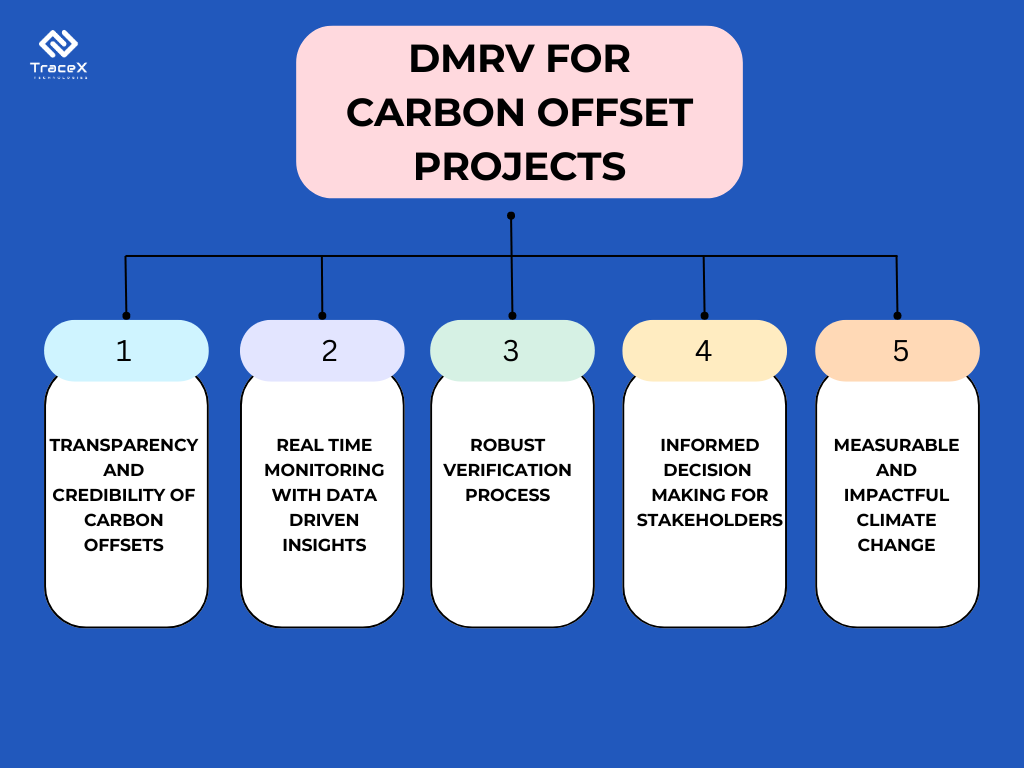Contact: +91 99725 24322 |
Menu
Menu
Quick summary: Explore the transformative potential of Digital MRV (Measurement, Reporting, and Verification) in nature-based carbon offset projects. Discover how advanced technologies like IoT, remote sensing, and blockchain are reshaping carbon reduction strategies. Dive into the significance of accurate measurement and verification, the role of digital MRV in addressing challenges, and the real-world impact on climate action.

Businesses are under increasing pressure to meet sustainability targets, and carbon offset projects are a critical part of that effort. But without a reliable way to measure, report, and verify emissions, achieving transparency and compliance can feel like a daunting task. Carbon MRV (Measurement, Reporting, and Verification) is a solution that’s making a real difference for companies seeking to take control of their carbon footprint.
Yet, choosing the right Carbon MRV platform can be overwhelming. With so many options available, how do you ensure that the platform you choose aligns with your specific goals, offers accurate data, and helps you stay compliant with ever-evolving regulations? Let’s dive into why selecting the right Carbon MRV solution is essential for your success.
Nature-Based Solutions involve the sustainable management and use of natural systems to address societal challenges. Examples include reforestation, agroforestry, wetland restoration, and sustainable agriculture. These solutions harness the power of nature to mitigate environmental issues while providing co-benefits like improved water quality, soil health, and livelihoods for local communities.
Nature-based Solutions (NBS) encompass a range of strategies that leverage the natural world’s ability to capture and store carbon dioxide from the atmosphere. These solutions harness ecosystems such as forests, wetlands, grasslands and oceans to sequester carbon through processes like photosynthesis, soil capture and marine algae growth. Forest restoration, afforestation, reforestation and sustainable land management practice like regenerative agriculture and agroforestry play a pivotal role in these strategies. The concept revolves around enhancing the earth’s innate capacity to absorb and store carbon offering a promising pathway to combat climate change.
The estimated mitigation potential of NbS if scaled-up, through avoiding carbon sources and enhancing carbon sinks, is roughly 10 gigatonnes CO2 per year. This is around 27% of global annual emissions.
Enhancing nature’s capacity for carbon absorption involves a strategic approach, encompassing ecosystem restoration, management and establishment. Among the most recognized NBS solutions is afforestation, involving tree planting to rehabilitate forests or creating new ones on agriculture lands. Utilizing a range of NBS types is essential to unlock their maximum potential for climate change mitigation, adaptation and holistic benefits for both humanity and the natural world.
Navigating ambitious corporate climate action can be a complex endeavour. After identifying emission sources, calculating GHG emissions and implementing reduction measures, the challenge remains: there are unabated emissions that can not be mitigated or avoided. While the technologies to enhance reduction goals are in development, there is an immediate solution available to address these unabated emissions, investing in globally recognized carbon offset projects.
Carbon Offset projects play a vital role in mitigating climate change by counterbalancing greenhouse gas emissions through activities that remove or reduce equivalent amounts of carbon dioxide from the atmosphere. These projects contribute to the global effort to achieve carbon neutrality and limit the impact of climate change. These projects could include reforestation, afforestation, renewable energy initiatives, methane capture and sustainable agriculture practices like regenerative agriculture and agroforestry.
These projects are crucial in achieving climate goals as they provide a practical avenue for organizations and individuals to compensate for their unavoidable emissions by investing in initiatives that help remove or prevent an equivalent amount of CO2. By supporting carbon offset projects, businesses can contribute to a more sustainable and environmentally responsible future.
Ensuring the effectiveness of nature-based projects relies heavily on accurate measurement and verification methods. Precise quantification of carbon sequestration and emission reductions achieved by these projects is paramount. Robust MRV mechanisms guarantee that the claimed carbon sequestration is scientifically rigorous and verifiable. They provide transparency, credibility and accountability which are essential factors for gaining stakeholder trust and achieving the desired climate impact. Accurate MRV not only verifies project outcomes but also informs decision-making, supports policy frameworks and contributes to global climate goals.
Digital Measurement, Reporting and Verification (DMRV) technologies have revolutionized the way carbon offset projects are monitored, evaluated and validated. Unlike traditional methods that often rely on manual data collection and complex calculations, digital MRV technologies utilize advanced tools such as satellite imagery, remote sensing, IoT sensors and data analytics to provide real-time and accurate measurements.
These technologies help to track project progress, quantify emission reductions and ensure transparency throughout the project life cycle. DMRV enhances efficiency, accuracy and accountability making it an essential component in the carbon offset initiatives.
An effective MRV system helps businesses:

DMRV involves a series of steps that facilitate the quantification of emission reduction resulting from a mitigation action. Subsequently this data is reported to the related stakeholders who then undertake the verification and certification of the outcomes. This rigorous process ultimately culminates in the issuance of carbon credits, signifying a tangible contribution to carbon offsetting initiatives.
DMRV technologies represent a groundbreaking approach to monitoring and assessing carbon offset projects. The tools leverage cutting-edge advancements such as remote sensing, IoT, data analytics and blockchain to transform the way we measure and verify carbon offset outcomes.
In the present era, satellites equipped with advanced remote sensing technology offer invaluable insights into carbon sequestration across diverse ecosystems like forests and wetlands. This data is pivotal in monitoring and validation of carbon credits. Leveraging satellite technology helps in streamlined monitoring and is cost effective that significantly expedites investments in natural solutions.
Implementing DMRV in nature-based projects involves meticulous planning, seamless data collection and robust security measures. By following these steps, organizations can harness the power of technology to enhance accuracy, transparency and effectiveness of carbon offset initiatives while contributing to climate goals.
Digital MRV tools can be selected based on the requirements of nature-based projects like type of ecosystem, data accuracy and scalability.
Define the emission reduction goals, measurement metrics, and reporting frequency to align with the chosen technology.
The necessary resources need to be allocated which includes funding, personnel, farms and land resources and technical expertise to support deployment, maintenance and operation of digital MRV systems.
Develop a plan for data collection including deployment of sensors, satellites and mobile apps to ensure that the entire project area is covered and captures the relevant parameters for accurate measurement. Data Collection envisages real-time monitoring, automated data collection, data integration and quality control.
In order to ensure data integrity and security in digital MRV systems, sensitive data needs to be safeguarded with a regular backup to avoid data loss. Implement a validation process to verify the accuracy of collected data against established standards. There is a need to maintain an audit trail to ensure transparency and accountability throughout the MRV process.
Collaborate with independent third-party organizations to validate the accuracy and integrity of data and the MRV process.
TraceX DMRV solutions empower carbon offset projects with cutting-edge technology, data driven insights and transparency leading to effective and impactful efforts in mitigating climate change and promoting environmental sustainability.
A Green Initiative Foundation aimed to enhance sustainability and environmental restoration by implementing large-scale Nature-Based Solutions (NBS) projects. By partnering with TraceX Technologies, the foundation was able to effectively utilize digital MRV (Measurement, Reporting, and Verification) tools to achieve their goals.
By leveraging TraceX’s digital MRV solutions, the Green Initiative Foundation was able to efficiently plan, monitor, and report on their Nature-Based Solutions projects. This collaboration highlights the potential of digital tools in driving sustainable development and environmental stewardship.
In conclusion, harnessing the power of DMRV in nature-based carbon offsets represents a transformative leap forward in our fight against climate change. The adoption of advanced technologies such as IoT, remote sensing and blockchain has revolutionized the way we monitor, measure and verify carbon sequestration and emission reduction activities.
DMRV is unlocking new avenues for precision, scalability and accountability in nature-based projects. It empowers us to make informed decisions, optimize our carbon offset strategies and expand our efforts on a global scale.
